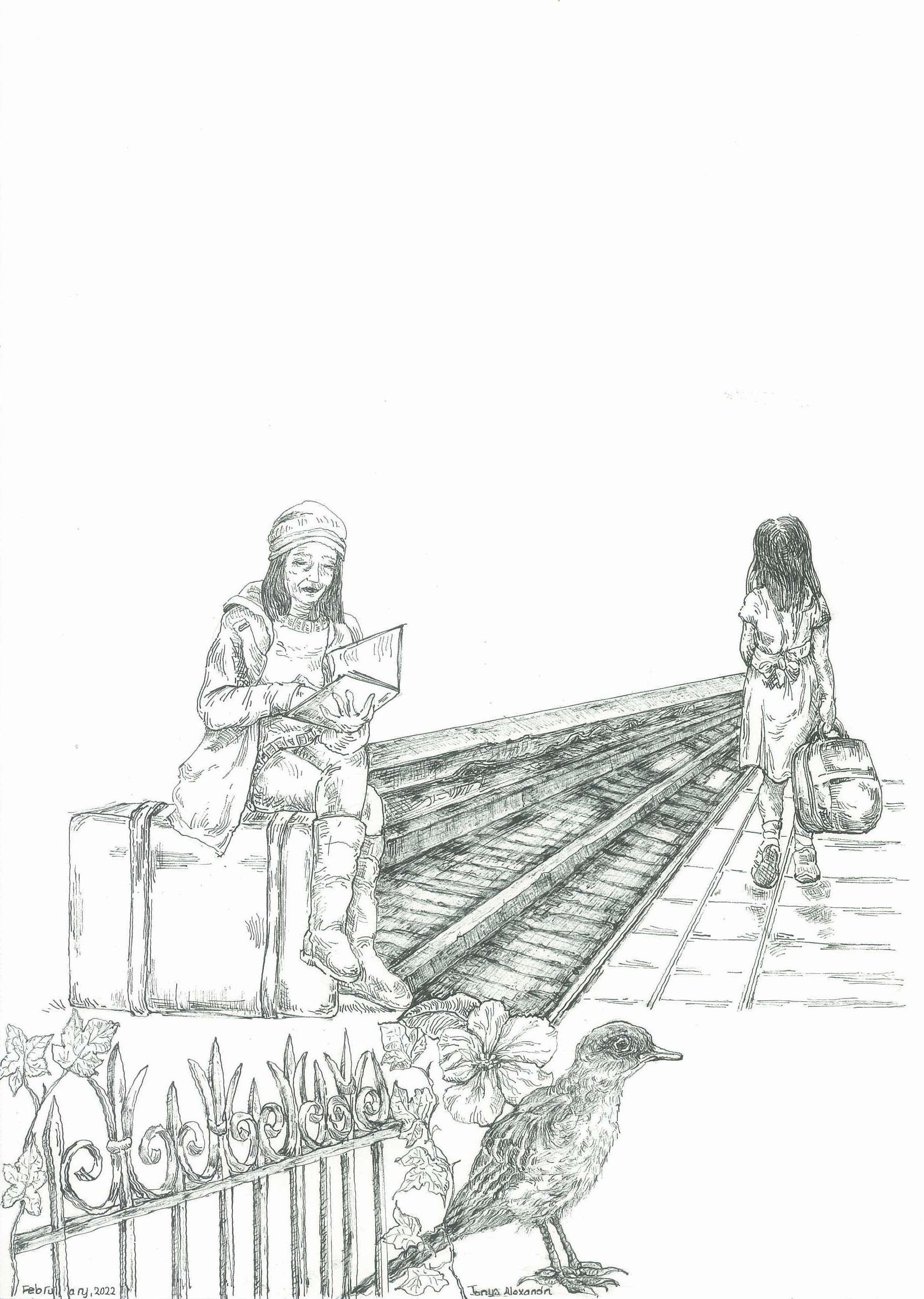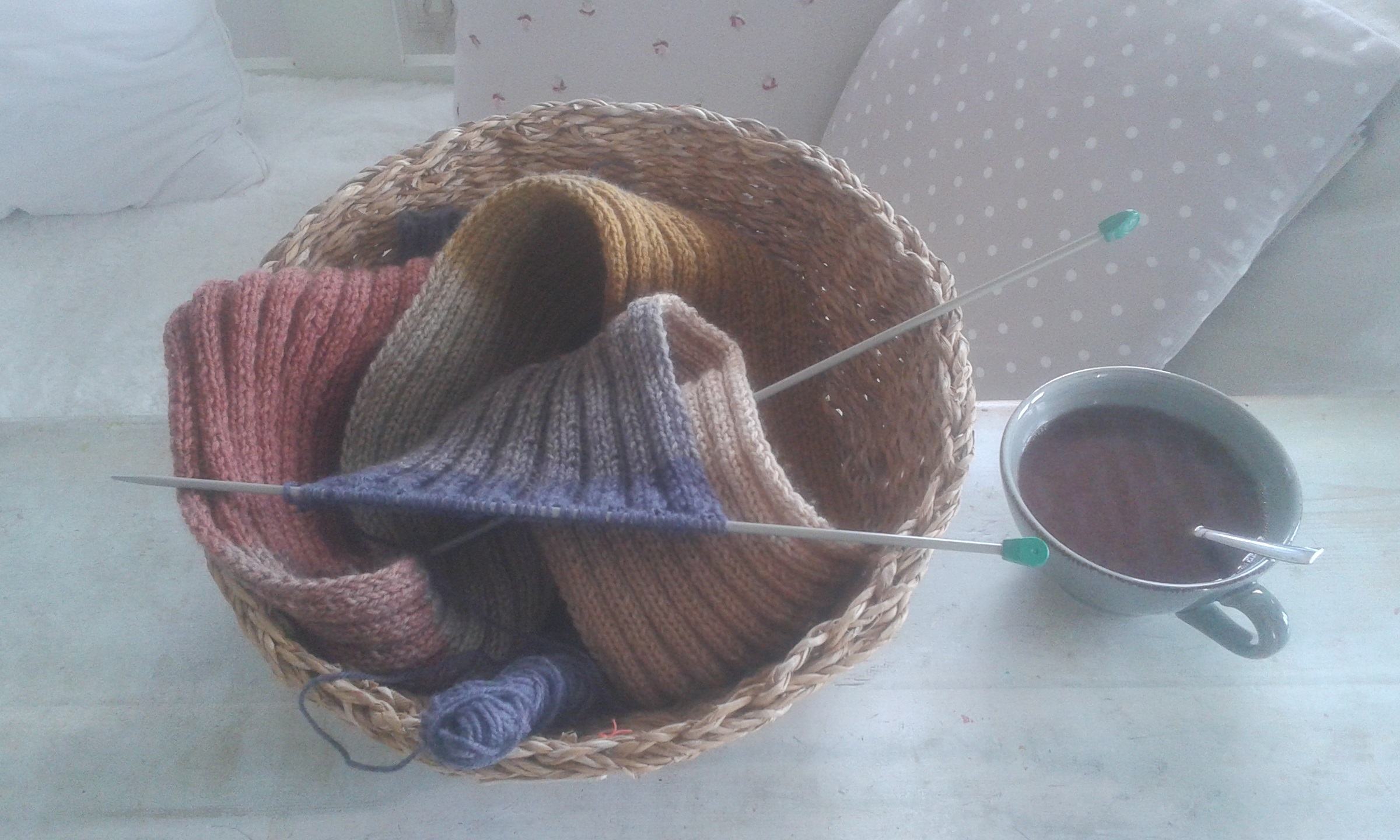Joy, public speaking and crafts
Part 2
Today’s post is also about joy in the broader sense. It also includes two more drawings and a few links of some of the “related to happiness and well being material” I listened to while knitting and drawing, like the podcast: Science of Happiness hosted by psychologist Dacher Keltner, Rick Hanson’s TED talk Hardwiring Happiness, where he mostly discusses his approach HEAL and how to install positive states to turn them into traits, and a TED talk by Steven Pinker, who points out that “there’s no limit to the betterments we can attain if we continue to apply knowledge to enhance human flourishing.”

 One step towards greater happiness or peace and contentment is learning to let go of constricting beliefs. In the book I referred to in the previous post, Awakening Joy for Kids, by James Baraz and Michele Lilyanna, there is a section on teaching children (and adults) to let go of constricting beliefs and wiring the brain for success. In this particular section they discuss how fear of public speaking is one of the most common phobias in North America, and I would suspect elsewhere, too, even though most people don’t discuss it nor do they tackle the problem, preferring to cope with the fear of public speaking by avoiding it all together. The authors write that “Throughout their lives people may pass up job opportunities, relationships, and the joy of pure self-expression by succumbing to this fear.” They then suggest that by supporting children at a young age to speak in front of peers in safe ways, rather than closing doors, this capacity could open opportunities.
One step towards greater happiness or peace and contentment is learning to let go of constricting beliefs. In the book I referred to in the previous post, Awakening Joy for Kids, by James Baraz and Michele Lilyanna, there is a section on teaching children (and adults) to let go of constricting beliefs and wiring the brain for success. In this particular section they discuss how fear of public speaking is one of the most common phobias in North America, and I would suspect elsewhere, too, even though most people don’t discuss it nor do they tackle the problem, preferring to cope with the fear of public speaking by avoiding it all together. The authors write that “Throughout their lives people may pass up job opportunities, relationships, and the joy of pure self-expression by succumbing to this fear.” They then suggest that by supporting children at a young age to speak in front of peers in safe ways, rather than closing doors, this capacity could open opportunities.
One of the authors narrates their own early disempowering experience at school during a speech. She writes “The teacher kept saying aloud, if you don’t do this, you will get a D … you will get a D. I was confronted with fear. Freeze, fight, or flight? I froze, then flew, and never forgot. I was not given a moment of compassion by my teacher or classmates, and I certainly didn’t know how to be self-compassionate.” Her own experience inspired her to introduce public speaking at an early age, and also, help her students to develop self-compassion. She suggests that teachers begin with small easy shares to build safety in the group; encourage older children to model this sharing in front of the younger children to inspire them; allow all children to take leadership roles in the classroom. She also suggests that the teacher demonstrate their own vulnerability by reading a speech in front of the children and talking about their own struggles, while eliciting from the children all the possible times it may be helpful to give a public speech and connecting this idea to things they love to do and how it can serve them in the future. She asks them to prepare very short speeches, teaches them about body language and body stress responses because she believes that by teaching children about the physiology of fear they might be more able to step back and hopefully notice and label the experience as fear and begin to talk themselves through the challenging situation. She also suggests sharing the brain science of how we wire in negative patterns that over time become stronger and more fixed into our neural pathways because what we rest our attention on repeatedly goes from a state to a trait. I will write more about this and about hardwiring happiness in the next post, in which I will draw on Rick Hanson’s book Hardwiring Happiness, which I’m currently reading.
In the book there are also home practices for parents to do with their kids in order to build this capacity early on at home. The basic ideas are to let kids play with their voices from an early age and then maybe capture this on camera to get them used to seeing themselves perform and share in safe ways. Other ideas are to have children put simple and very short plays on for their family or an audience because the joy of sharing aloud will build courage and competence or to ask kids to read books aloud to younger siblings and children to make it easier for them to speak up in class. Singing songs with your children also builds up confidence and ease. From experience I know that singing accelerates learning – of the alphabet, grammar, vocabulary – increases fluency and makes learning more fun. Any activity that encourages children to express themselves safely, in class or at home, is a positive step.

Some of the practices in the book incorporate crafts like sewing and weaving. Crafts are fun, they help children develop small motor skills, they help increase focused attention and creativity, they can be done alone, in groups or with family. Engaging with crafts and hobbies increases our contentment and can also be soothing and relaxing. Reading through the craft sections brought up the desire in me to knit or crochet something (I hadn’t done this in a long time). I actually knitted myself a scarf this last week (see picture). I knitted both mindfully letting the repetitive motions do whatever they do, and I knitted while listening to and watching things.
I also looked up articles and research on the potential positive effects of knitting. It is generally suggested that knitting can be like mindfulness meditation. The repetitive and rhythmic movements are equated with meditation, and they also, have a calming effect, which can decrease pain, depression, stress and anxiety. Studies also suggest that engaging in activities like crocheting and knitting frequently could reduce the chance of developing cognitive impairments for the elderly, and can lower heart rate and blood pressure and reduce levels of cortisol. One study revealed a connection between knitting and feeling of happiness. It probably also increases patience and the end products give us satisfaction. In a research article by Jill Riley, et al. (2013) on the benefits of knitting for personal and social wellbeing the results showed a significant relationship between knitting frequency and feeling calm and happy and that the more frequent knitters reported higher cognitive functioning. Additionally, more serotonin is released with repetitive movement, which improves mood and sense of calmness. Also, knitting in a group impacted significantly on perceived happiness, improved social contact and communication with others.
The authors of Awakening Joy for Kids write “These days fewer people know how to knit, weave, or crochet but all is not lost to past generations. We can bring back this beautiful art in small and big ways and at the same time bring health and well-being into our minds and bodies. You don’t even need to knit. Repetitive movements are common sense: we rock babies in cradles and sit in rocking chairs because rocking has a powerful calming effect.” They quote Dr. Herbert Benson, who recommends the repetition of a sound, a word, a phrase, and muscular activity to elicit our body’s relaxation response, can lower heart rate, blood pressure and muscle tension.
Links
https://greatergood.berkeley.edu/podcasts?utm_source=Greater+Good+Science+Center&utm_campaign=52547b228d-EMAIL_CAMPAIGN_GG_Newsletter_February_8_2022&utm_medium=email&utm_term=0_5ae73e326e-52547b228d-70743655 (Dacher Keltner’s podcast)
https://www.ted.com/talks/steven_pinker_is_the_world_getting_better_or_worse_a_look_at_the_number (Steven Pinker)
https://www.youtube.com/watch?v=jpuDyGgIeh0 (Rick Hanson TED talk)
